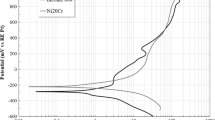Abstract
This investigation potentiodynamically evaluates the corrosion behavior of a high strength titanium alloy, VT-9, in 4 M sulfuric acid solution containing different concentrations (10, 20, 30 ppm) of the organic inhibitor, 2-phenyl-4-[(E)-1-(4-sulfanylanilino)methylidene]-1,3-oxazole-5(4H)-one (L-SH), at different temperatures (293, 303 and 313 ± 1 K). The open circuit potential values noted before and after each experiment varied appreciably with time. These values, in the presence of L-SH, were negative before polarization, but after completion of the experiment turned positive and remained stable over a long period of time. The cathodic current density values increased with increasing cathodic potential (more negative). The corrosion potential (Ecorr) increased remarkably with the addition of L-SH. The corrosion current densities (Icorr), critical current density (Icr), and passive current density (Ip) all decreased when L-SH was used. However, only the decrease in the Icorr with increasing amounts of inhibitor was significant compared to that of Icr and Ip. L-SH expanded the range of the passive potential. SEM micrographs and open circuit potential measurements revealed the formation of a uniform and protective film on the alloy surface in the presence of L-SH, which acted as an efficient inhibitor.
Similar content being viewed by others
References
L.J. Barron, Light Metal Age. 14 (1956) 16.
V.S. Ivins, Power Eng. 69 (1956) 52.
E. Leitao, R.A. Silva, M.A. Barbosa, Corros. Sci. 3 (1997) 337.
K. Elagli, M. Traisnel, H.F. Hildebrand, Electrochim. Acta 38 (1993) 1769.
Z. Han, H. Zhao, X.F. Chen, H.C. Lin, Mat. Sci. Eng. A-Struct. 277 (2000) 38.
R.S. Glass, Y. Ki Hong, Electrochim. Acta 29 (1984) 1465.
M.J. Mandry, G.J. Rosenblatt, J. Electrochem. Soc. 106 (1959) 755.
I. Gurrappa, Mater. Charac. 51 (2003) 131.
D.W. Deberry, G.R. Peyton, W.S. Clark, Corrosion. 40 (1981) 250.
E.E. Ebenso, Mater. Chem. Phys. 71 (2002) 62.
H. Ashassi,- Sorkhabi, S.A. Nabavi-Amri, Acta Chim. Slov. 47 (2000) 587.
E.E. Oguzie, C. Unaegbu, C.E. Ogukwe, B.N. Okolue, A.I. Onuchukwu, Mater. Chem. Phys. 84 (2000) 364.
E.S. Ferreira, C. Giacomelli, F.C. Gicomelli, A. Spinelli, Mater. Chem. Phys. 83 (2004) 129.
I. Lukovists, E. Kalman, F. Zuchi, Corrosion 57 (2001) 3.
N. Hackerman, E.L. Cook, J. Electrochem. Soc. 97 (1950) 2.
E. Ahlberg, M. Friel, Electrochim. Acta 34 (1989) 190.
A.P. Brynza, L.I. Gerasyutina, J. Appl. Chem. 35 (1962) 660.
L.I. Gerasyutina, A.P. Brynza, J. Appl. Chem. 368 (1963) 2132.
J.A. Petit, G. Chatainier, F. Dabost, Corros. Sci. 21 (1981) 279.
V.B. Singh, S.M.A. Hosseini, Corros. Sci. 34 (1993) 1723.
V.B. Singh, S.M.A. Hosseini, J. Appl. Electrochem. 24 (1993) 250.
A.M. Al-Mayouf, A.A. AL-Swayih, N.A. Al-Mobarak, A.S. Al-Jabab, Mater. Chem. Phys. 86 (2004) 320.
S.M.A. Hosseini, V.B. Singh, Mater. Chem. Phys. 33 (1993) 63.
S. Bilgic, M. Sahin, Mater. Chem. Phys. 70 (2001) 290.
E.E. Ebenso, Mater. Chem. Phys. 71 (2002) 62.
A.M. Al-Mayouf, Corros. Prevention Control 6 (1996) 70.
M.P. Soriaga, A.T. Hubbard, J. Electroanal. Chem. 165 (1984) 79.
M.T. Makhlouf, G.K. Gomma, M.H. Wahdan, Z.H. Khali, Chem. Phys. 40 (1995) 119.
A. Fragnani, G. Trabanelli, Corrosion 55 (1999) 653.
G.K. Gomma, M.H. Wahdan, Bull. Chem. Soc. Jpn. 67 (1994).
D.J. Shaw, Introduction to Colloid and Surface Chemistry, Butterworth, London, 1966.
D. Schlain, C.B. Kenahan, Corrosion 14 (1958) 405t.
G.W. Poling, J. Electrochem. Soc. 114 (1967) 1209.
Author information
Authors and Affiliations
Corresponding author
Rights and permissions
About this article
Cite this article
Hosseini, S.M.A., Amiri, M. Electrochemical and dissolution behavior of the Ti-alloy VT-9 in H2SO4 solution in the presence of the organic inhibitor (2-phenyl-4-[(E)-1-(4-solphanylanilino)methylyden]-1,3-oxazole-5(4H)-one. JICS 4, 451–458 (2007). https://doi.org/10.1007/BF03247232
Received:
Accepted:
Issue Date:
DOI: https://doi.org/10.1007/BF03247232




